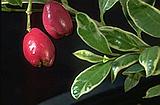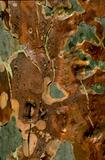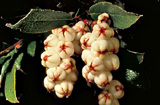|
[Front Page] [Features] [Departments] [SGAP Home Page] [Subscribe]

Flowers.....Who Needs 'em?!!!
Brian Walters
Let's face it. Most of us are obsessed with flowers.
Colourful, spectacular, humungous flowers.
There's nothing wrong with that of course, but most native and exotic shrubs flower for periods of few weeks to a couple of months. There are exceptions....Grevillea "Robyn Gordon" and similar hybrids come to mind. But a garden should be a place of enjoyment year round, so it makes sense to look at the other features of plants.
Gardens need a selection of plants that complement each other through a whole range of features including foliage, fruit and growth habits. In this way, our gardens can be places of interest even on the hottest, driest summer day or in the depths of winter.
Apart from flowering characteristics, factors worth considering include:

|
- The normal colour of foliage.
- The colour of new season's growth.
- The shapes and textures of the leaves.
- Foliage fragrance.
- The growth habit.
- Features of tree trunks.
- Features of seeds and fruit.
|
Lets look at these characteristics separately and consider just a few examples of each.
Foliage Colour
OK. Most plants have green foliage but there is a whole host of shades of green from the glossy deep shades of many rainforest species through to grey or silver tones of plants from drier areas.
Some of most attractive plants for foliage colour are the persoonias ("geebungs"). Many of these have leaves of a light, fresh green even through the severest drought. At the other extreme, a number of Eremophila species ("emu bushes") have distinctive silver foliage (eg. E.nivea and forms of E.glabra).
Eucalypts also have an interesting range of foliage colours. The "candle bark" (E.rubida) is a beautiful grey-foliaged, large tree which also has an attractive trunk. Among the smaller gums the well known "Argyle apple (E.cineria) is often grown for its grey-green, juvenile foliage.
The wattles, also, include many members with attractive foliage colours. The silvery-grey foliage of the "Cootamundra wattle" (Acacia baileyana) always attracts attention although this species should be avoided near natural bushland due to its weedy tendencies. Perhaps the most attractive foliage of all wattles, though, is borne on A.glaucescens. In the best forms the leaves are a beautiful grey-green with a velvety texture. The colourful yellow flowers are almost unnecessary!
Plants with variegated foliage (ie. leaves mottled with cream or yellowish markings) shouldn't be overlooked. Use of these types of plants can be overdone in a garden but one or two with this feature add interest. Commonly available variegated plants include forms of Syzygium paniculatum and the climber Pandorea jasminoides. Variegation is sometimes an unstable feature, so if the plant is noted producing branches with pure green leaves these are best pruned off.
 |
Plants with variegated foliage can be attractive but should be used sparingly. This is Syzygium paniculatum. Select the thumbnail image or plant name for a higher resolution image (25k).
|
The Colour of New Growth
Apart from their normal foliage colour, many plants produce a flush of new growth that can rival the most spectacular of flowers. Other plants produce a more subtle tone.
Useful plants in this category include rainforest species such as Syzygium luehmannii, Eugenia wilsonii and Davidson's plum (Davidsonia pruriens). Many grevilleas, banksias and hakeas could also be considered along with the widely grown bottlebrush, Callistemon salignus (sometimes called "Pink Tips" because of the colour of its new foliage).
 |
The new growth of many plants can rival the most spectacular of flowers. This is Davidson's plum Davidsonia pruriens. Select the thumbnail image or plant name for a higher resolution image (27k).
|
Leaf Shapes and Textures
Some of the most interesting leaf shapes occur among the members of the Protea family. The serrated leaves of many Banksia and Dryandra species are always interesting. Perhaps one of the best is Banksia robur which has leaves up to 350 mm long by about 100 mm wide. An added bonus is the soft and velvety, rusty new growth which contrasts strongly with the rough, leathery texture of the mature foliage.
The rounded juvenile foliage of some eucalypts (such as E.cineria) is very attractive although the shape can be lost as the plants mature.
Don't forget the "pricklies" also! Many people have a prejudice against any plant which isn't soft to the touch. But plants with sharp spines or needles have their place (who said "somewhere else"?). These types of plants are useful to deter foot traffic in areas where dogs and kids might cause damage and they offer a sanctuary to small birds from the predation of cats or larger birds. Apart from this, it's interesting to watch the expressions on the faces of unsuspecting visitors when they back into one of your favourite "nasties"!
Among the "pricklies" the hakeas stand almost unchallenged. Grabbing a handful of H.teretifolia (appropriately called the "dagger hakea") is an experience not soon forgotten, but Grevillea dielsiana can be almost as painful!
Aromatic Foliage
Many plants have leaves containing aromatic oils, some of which (eg "tea tree oil" from Melaleuca alternifolia) have commercial value. These plants can release pleasant fragrances when brushed against or after rain and this adds immeasurably to the character and "feel" of a garden.
Some of the best are the "mint bushes" (Prostanthera species) which are generally small to medium shrubs and Backhousia species which are small to medium trees. The foliage of B.citriodora has the most intense lemon fragrance and B.anisata has foliage which smells strongly of aniseed.
Growth Habits
Apart from features of the individual leaves, the overall growth habits of plants can add interest to a garden. Plants with a weeping shape where foliage cascades downwards are particularly appealing. Two of the best of these are the "weeping bottlebrush" (Callistemon viminalis)and the "willow gum" (Eucalyptus scoparia). As a bonus, the latter has a beautiful white bark.
Plants with tufted, grass-like growth habits can also make interesting features. The "kangaroo paws" (Anigozanthos species) are in this category as are the related Conostylis species.
Tree Trunks
This is probably the most ignored feature when selecting trees for the garden but, after height, it's really the most important factor of all.
Once any tree gets to a reasonable size, its trunk becomes its most conspicuous feature. All of the branches and foliage might be 10 metres or more above the ground but the trunk is right there in the direct line of vision! So, it makes sense to consider the attraction of the trunk before planting.
Eucalypts, for example, have trunks with a whole range of features from the smooth-barked species such as the "Willow Gum" through the fibrous "Stringybarks" to the rough, black "Ironbarks".
Others worth considering are the "Paperbarks" such as Melaleuca quinquenervia.
 |
Many eucalypts are worth growing for their attractive bark. One of the best is the "Spotted Gum", Corymbia maculata. Select the thumbnail image or plant name for a higher resolution image (29k).
|
It's a good idea to locate trees with attractive trunks carefully. It's no good planting them behind a mass of dense, screening foliage, for example. They need to be seen! So try to find a place where they can be viewed from regularly used areas.
Fruits and Seeds
Plants produce fruits of a bewildering range of shapes, sizes and textures.
Berry-type fruits are usually colourful and sometimes edible. For example, the colourful, fleshy fruits of the lily pillys (Syzygium and Eugenia species) can be as spectacular as any flower and are often used to make jams. But there are many others worthy of a place in the garden. These include Pittosporum rhombifolium (a beautiful small tree with masses of orange berries in autumn), the "Blueberry Ash" (Elaeocarpus reticulatus) and the uncommon Gaultheria appressa, which produces cream berries and is related to the exotic azaleas.
 |
Gaultheria appressa is a small shrub which is native to higher altitudes in Victoria and NSW. It is not often cultivated. Select the thumbnail image or plant name for a higher resolution image (23k).
|
 |
This attractive combination of yellow fruit and glossy black seeds occurs with Pararchidendron pruinosum, a rainforest species. Select the thumbnail image or plant name for a higher resolution image (29k).
|
In complete contrast are the hard textured fruits such as those on Banksia, Isopogon and Hakea species. These may not have the general appeal that colourful berries have, but they add character. I simply can't imagine a garden without a few Banksias present....
Take It Easy
With all of these features to add character to the garden, it's easy to become over-enthusiastic. While garden design is a personal thing, there can most definitely be too much of a good thing. Unless you're a collector of specific types of plants, you probably don't want the garden to end up as a "dog's breakfast" of many different foliage colours and shapes.
However, including plants which encompass all of the features described (as well as those with colourful flowers) will enhance the attraction of the garden and make it a place where you will want to spend some time right throughout the year.
Based on an article published in the September/October 1994 issue of "Gardens and Backyards" magazine.
Brian Walters has been growing Australian plants since the early 1970s. He is a Public Health Engineer and technical writer and obtained his enthusiasm for the Australian flora while working within the water catchment areas maintained by his former employer, Sydney Water. He has been a member of the Australian Plants Society for over 20 years and is currently the newsletter editor for the New South Wales Region of the Society.

[Front Page] [Features] [Departments] [SGAP Home Page] [Subscribe]
Australian Plants online - June 1998
The Society for Growing Australian Plants
|